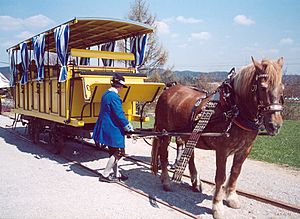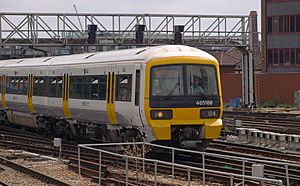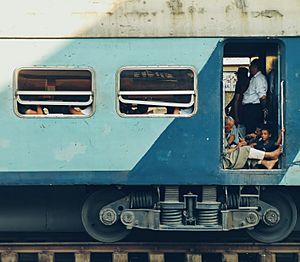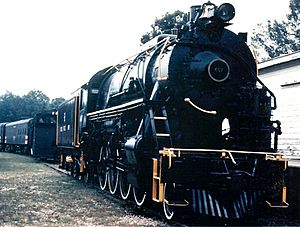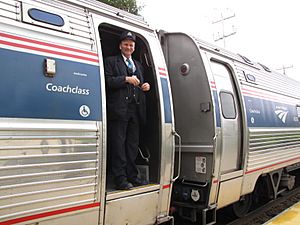Train facts for kids
A train is a set of carriages on a railway. A place where a train stops to let people get on and off is called a Train station or railway station. Early trains used horse power and ran on wooden or iron tracks. These were used in the Middle Ages. The first steam trains were built in England in the early 19th century. Long before railways, "train" meant any group of vehicles or pack animals traveling in a line, as in wagon train or camel train.
Trains contain the prime mover (either locomotive or motor unit) and one or more cars. The locomotive or railway engine (usually the first car of the train) pulls the cars along the track. The last car you will see on a train is called the caboose. Some trains look like a special bus that can only drive on rails. Trains are used to carry people, as well as cargo, such as raw material,finished goods, and waste.
Types of train
Freight
Freight trains have freight carriages to carry goods from one place to another. Some are boxcars (closed and roofed cars for cargo); others are special so they can carry special cargo. There are hopper cars for sand, coal, ore and other granulous (sand-like) materials, flatbed cars for vehicles and machinery, tank cars for liquids, container cars for containers and even bottle cars for molten iron. Almost anything which is not too large to fit under tunnels and bridges can be transported on special freight carriages.
Passenger
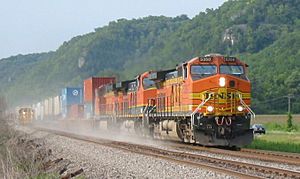
Passenger trains have passenger carriages made so people can ride them from one train station to another. There are few long-distance passenger trains in the United States, but more in Europe and Asia. Most passenger cars are single-deckers: there are also double-decker passenger cars, such as the Finnish Inter-City cars.
Passenger trains are usually a very comfortable way of traveling. Many trains have electrical outlets and Wi-Fi hotspots for computers, and a special restaurant car for dining and refreshments. There are also sleeping cars (passenger cars with beds) for long overnight voyages.
High-speed rail uses special, fast passenger trains on special tracks. A few very fast ones are maglev trains using magnets to hover slightly off the tracks to have less friction.
Crew
- The driver or engineer makes sure the train works right, and speeds it up or slows it down. Every train needs a driver to make it run well.
- The guard or conductor makes sure the train goes the right way and tells the driver if he makes a mistake.
- Only steam trains have a fireman. He makes sure the fire that powers the steam locomotive is burning properly by putting coal into the fire.
Propulsion
Most trains are pulled by locomotives. Before 1900, almost all were steam locomotives. As this kind of steam engine uses very much fuel for the work it does, steam began to give way to diesel locomotives and electric locomotives during the 1930s. Today, most locomotives are diesel-electric locomotives.
Sometimes a train has no separate locomotive, but the prime mover (diesel engine or electric motor) is located on the first car of the train itself, and the car has engineer's cabin. The car is called a "motor unit". Some trains have motors in many or all of the cars. This is called a diesel multiple unit or electric multiple unit. Usually, both ends of the train have engineer's cabins. These trains are especially popular in commuter traffic in large towns and cities. Electric trains get their power from a third rail or from overhead wires.
Images for kids
-
A Union Pacific intermodal freight train in Arizona, U.S.
-
Arrival of the Normandy Train, Gare Saint-Lazare, by Claude Monet, 1877, Art Institute of Chicago
-
Interior of a passenger car in a long-distance train in Finland
-
The Shinkansen N700 Series Nozomi travels between Tokyo and Osaka in around two and a half hours.
-
The Electric Tilt Train, the fastest train in Australia, operates between Brisbane and Rockhampton in Queensland, a distance of 615 km.
-
A "tube train" on the London Underground
-
An Aurizon freight train in Fremantle, Western Australia
-
Swiss Electric locomotive at Brig, Switzerland
See also
 In Spanish: Tren para niños
In Spanish: Tren para niños


